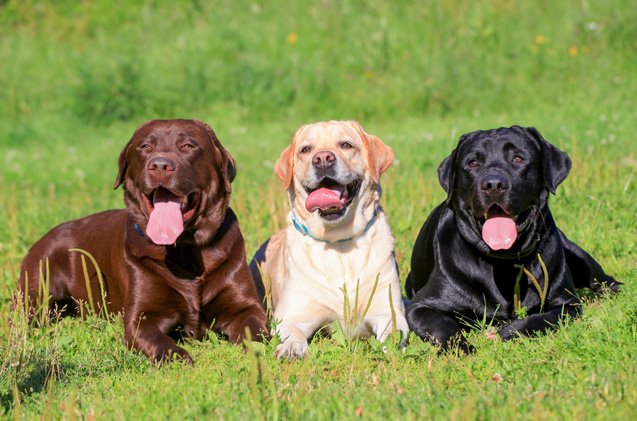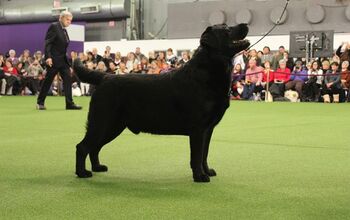Labrador Retriever


About Labrador Retriever
Some dog breeds need to be sold to potential dog owners as they might not be familiar with the intricacies of what makes those particular pups special. Other breeds are so legendary that the name is a selling point in and of itself. Enter the Labrador Retriever. The reputation of this beloved breed speaks for itself. There’s a reason why suburbs are filled with these fine animals and why seemingly every family wants to bring one into their homes. These dogs live up to the hype.
Labrador Retrievers are among the most popular dog breeds out there today for a reason. Loyal, easy to get along with, and easy to train, these retrievers could be considered a neighborhood classic all around the United States and even in other parts of the world. It’s hard to find anything negative to say about these remarkable pooches and they are guaranteed to remain family favorites for generations to come. But what exactly makes Labrador Retrievers such popular and well-respected dogs? Does a strong breed always mean that a Labrador Retriever will be the right dog for you? The answers to these questions and many more can be found below. So if you’ve ever considered bringing home a Lab Retriever, you’ve come to the right place. Keep your eyes glued to this page and scroll away. By the end of this article, you’ll either be racing out to get a Lab or beginning your search for a new breed.
But what exactly makes them such popular, well-respected dogs… and does a strong breed always mean that a Labrador Retriever will be the right dog for you?
Canadian in decent, Labrador Retrievers originated in Newfoundland, having descended from the St. John’s Water Dog around the 16th century. The smaller versions of the St. John’s Water Dog were often used to retrieve as well as pull in fishing nets, giving this breed of dog a true working class background. Many people will observe that the personality of Labrador Retrievers is a strong indication of this background. These dogs are happiest when performing a task with their humans, after all.
Descending from Portuguese, English, and Irish breeds, the Labrador Retriever could be considered a classic “blue-collar” dog. It is not quite on par with some hunting dogs, but certainly one of the more favorable “working” dog breeds available out there today. More recent history through previous centuries brought the Labrador Retriever back to England where it became a popular sporting and hunting dog. These dogs may have started in Canada, but they belong to the world now.
As the Labrador Retriever descends from St. John’s Water Dogs, it certainly has a long way to trace its history and pedigree through the years, and is a direct descendant of popular European dogs throughout the High Middle Ages and onward. Although the Labrador Retriever was bred in the New World, it certainly has strong ties to other European breeds, though in the United States and the United Kingdom it has become perhaps the go-to breed in the world of registered pets.
Golden Retrievers are a separate breed from the Labrador but you’ll notice they share many common characteristics both physically and socially.
The Labrador Retriever can come in a few colors, including Yellow and Chocolate.
Labrador Retrievers tend to be more active, larger dogs and consequently need a fair amount of food in comparison with many dogs. Without plenty of activity, it is common for people to overfeed a Labrador Retriever and this leads to seeing plenty of overweight Retrievers. But what exactly makes an adequate Retriever diet?
Although Labrador Retrievers are a larger breed of dog, it’s important to remember that they still should only get to around 80 pounds on the higher end for males and 70 pounds for the females. Many people are tempted to feed their Retriever like they’re another person in the home, but keep in mind that even an adult Retriever is typically just half the size of an average adult human.
Like with many dogs, meats are popular as well as vegetables and many types of all-purpose dog food can be considered suitable for Labrador Retrievers.
As always, if you are ever concerned about establishing or altering the diet of your Labrador Retriever, it’s always wise to consult with a veterinarian first. While dog food manufacturers and pet blogs provide useful feeding guidelines that are worth consulting, they are still just guidelines and not exactly gospel. All dogs are different after all, each with their own needs. The only person qualified to determine the specific dietary needs of your personal pooch is your vet. So always lean on their expertise before making any major changes to what fills up your Lab’s food dish.
Labrador Retrievers can put up with a lot of training and generally respond well to behavior training.
Considered versatile, Labrador Retrievers can put up with a lot of training and generally respond well to behavior training. They are not excessively territorial or aggressive despite their large size and will often respond with all of the loyalty and obedience as you’re capable of giving. For people who aren’t interested in doing a lot of training on their dog, a Labrador Retriever makes an ideal dog because it will not always require a lot of work to keep it within the bounds of acceptable behavior. This isn’t to say that all Labrador Retrievers will respond this way, however. It’s still important to commit to a training regime. Just like with any dog, this regime should be focused entirely on positive reinforcement and rewards-based training. Anything less is closer to abuse than training. Not only will that harm your dog, it will never deliver the training results that you desire. Negative training techniques should be avoided at all costs.
As mentioned earlier, a typical healthy weight for an adult male Labrador Retriever is around 70-80 pounds and around 60-70 pounds for an adult female. If your Labrador Retriever tips the scales at 100 pounds, it would be considered officially obese and would benefit greatly from a weight loss regimen. Growing only to a few feet tall, Labrador Retrievers can be heavier dogs considering their relatively small frames, so be sure that your Labrador Retriever gets plenty of activity on a daily basis.
Friendly, accepting and not territorial, Labrador Retrievers are ideal house pets. Despite their relatively large size, Labrador Retrievers are not a particularly hostile or aggressive breed and bond quite easily with children and adults alike. Because they are called “Retrievers,” Labradors make a perfect dog for tossing a Frisbee or a ball outside and respond well to play. Labradors are also excellent swimmers and love to get outdoors during the summer. These dogs are absolute sweethearts and the loving relationship that they form with their humans is a major reason why Labrador Retrievers have grown into such a popular and beloved breed.
In addition to a few inherited disorders such as cataracts and hip and joint problems, Labrador Retrievers are susceptible to obesity if they do not receive a proper diet and a healthy amount of exercise. Your Labrador Retriever’s health problems are likely to include joint issues, particularly if your dog is overweight and has been for a period of time. It’s important to maintain regularly scheduled checkups with a veterinarian to ensure that any potential health issues are identified and treated as quickly as possible.
A relatively normal life expectancy of around 10-12 years makes Labrador Retrievers a solid breed to grow up with your children.
Labrador Retrievers can get heavy quickly and do require a lot of exercise. Luckily, the breed responds well to physical activity and is anxious to exercise throughout the day. Throwing a ball or Frisbee in the backyard can help keep your Labrador Retriever busy and panting even when you don’t particularly feel like moving around too much yourself. However, for the sake of your Lab’s health (and to ensure that they don’t burn off any excess energy in a more mischievous manner), it’s important to try and keep up with your Labrador Retriever and fulfill their exercise requirements every day. As a bonus, it’ll also fulfill your daily exercise requirements as well! So, that’s a plus, right?
Friendly, accepting and not territorial, Labrador Retrievers are ideal house pets.
The American Kennel Club calls the Labrador Retriever “gentle, intelligent and family-friendly.”
Labrador Retrievers typically have short coats with colors ranging everywhere from Yellow to Chocolate. You might even see fox-colored Retrievers. Labrador Retrievers will shed as they’re double-coated, but its coats are quite water-resistant which makes them great swimmers.
Generally, Labrador puppies should not be brought home before 7-10 weeks old, but many people enjoy Labrador puppies and find that once they adjust to life in the house they can make entertaining pets. Training and socialization should begin as early as possible to ensure those early and impressionable puppy days don’t go to waste.
Photo credit: Marina Jay/Shutterstock

Amy Tokic, Editor of PetGuide.com, is a passionate animal lover and proud pet parent of Oscar, a Shih Tzu/Chihuahua cross, and Zed, a Japanese Chin. Her love of animals began in kindergarten, when she brought her stuffed dog Snoopy into class with her every day. Now, she writes about her adventures in pet ownership and tirelessly researches products, news and health related issues she can share with other animal enthusiasts. In her free time, Amy loves perusing used book and record stores, obsessing over the latest pet products available and chasing squirrels with wild abandon (a habit attributed to spending too much time with her pooches).
More by Amy Tokic












![It’s Kitten Love For This London Labrador Retriever [Video]](https://cdn-fastly.petguide.com/media/2022/02/28/8276404/its-kitten-love-for-this-london-labrador-retriever-video.jpg?size=350x220)












